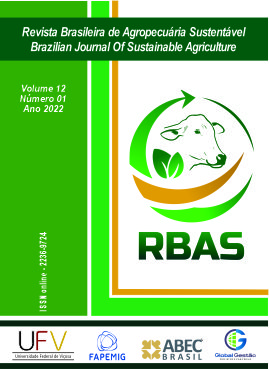ADJUSTING THE OPTIMAL ARRANGEMENT OF PLANTS TO MAXIMIZE THE PRODUCTIVITY AND QUALITY OF LINSEED GRAINS
DOI:
https://doi.org/10.21206/rbas.v12i1.14242Palavras-chave:
Linum usitatissimum, dissimilaridade, correlação linear.Resumo
Understanding and exploring the productive potential of crops guarantees the economic
return and sustainability of the activity. In addition to genetic improvement and biotechnological events,
crop management practices contribute to the expression of high crop performance. The aim of this work was
to highlight the effects of row spacing and seed densities on the agronomic performance of flaxseed. The
trial was developed in the experimental area of the Regional Institute of Rural Development, which belongs
to the Regional University of the Northwest of the Brazilian State of Rio Grande do Sul. The experimental
design was randomized blocks, and the treatments were structured in factorial scheme three (spacings) x
six (densities) with three replications per treatment, totaling 54 experimental units. We used three spacings
between rows, 18 cm, 36 cm and 54 cm, and densities of 30, 60, 90, 120, 150 and 180 seeds per linear meter.
The experimental units were three meters wide by 10 meters long, totaling 30 square meters. The variables
analyzed are divided into three morphological groups: plant height, height of insertion of the first capsule,
number of branches at the base, stem diameter, number of stem branches, number of productive branches;
productive variables: number of capsules per plant, capsule mass, number of capsules that formed grain,
number of capsules that did not form grains, number of grains per plant, mass of grains per plant, mass of one
thousand grains and grain yield; meteorological variables: rainfall (mm), minimum air temperature (°C) and
maximum air temperature (°C). Grain yield reduces when growing at larger spacings. The highest expression
of grain yield occurs in row spacing of 18 cm. Indirect selection for linseed grain yield can be performed
through the number of stem branches, number of productive branches, number and weight of capsules and
number of grains per plant.
Downloads
Downloads
Publicado
Como Citar
Edição
Seção
Licença
Copyright (c) 2022 Revista Brasileira de Agropecuária Sustentável

Este trabalho está licenciado sob uma licença Creative Commons Attribution-NonCommercial-NoDerivatives 4.0 International License.
1. Proposta de Política para Periódicos de Acesso Livre
Autores que publicam nesta revista concordam com os seguintes termos:
Autores mantém os direitos autorais e concedem à revista o direito de primeira publicação, com o trabalho simultaneamente licenciado sob a Licença Creative Commons Attribution que permite o compartilhamento do trabalho com reconhecimento da autoria e publicação inicial nesta revista.












